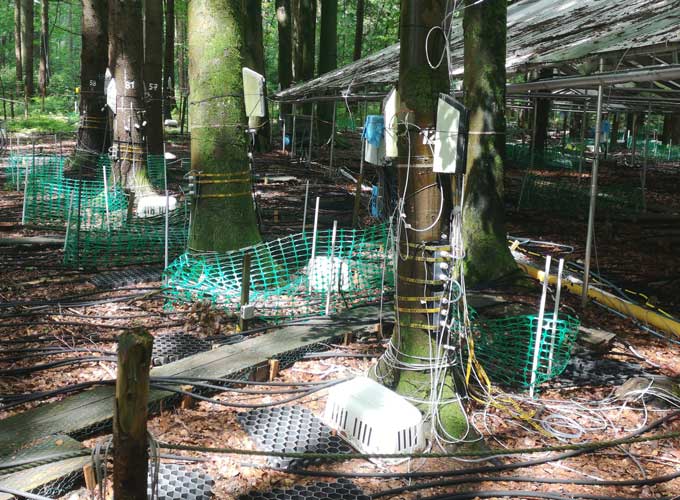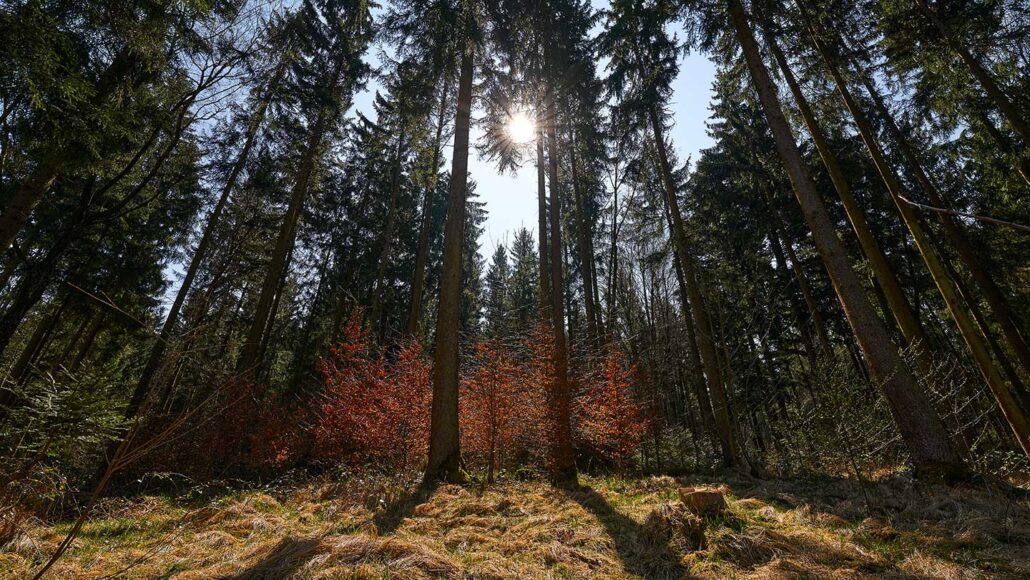Ultrasound reveals trees’ drought-survival secrets
The tissues of living trees may hold the secrets of why some can recover after drought and others die. But those tissues are challenging to assess in mature forests. After all, 90-year-old trees can’t travel to the lab to get an imaging scan. So most studies of the impacts of drought on plants are done in the lab and on younger trees — or by gouging cores out of mature trees.
Barbara Beikircher, an ecophysiologist at the University of Innsbruck in Austria, and colleagues came up with a different approach: They brought the lab to the trees.
In the Kranzberg Forest outside Munich, the team outfitted stands of mature spruce and beech trees with rugged, waterproof ultrasound sensors. Some of the stands had been covered by roofs to block the summer rain, creating artificial drought conditions.

Researchers outfitted stands of mature spruce and beech trees with ultrasound sensors and electrical probes to figure how the species cope with long dry spells.UNIVERSITY OF INNSBRUCK
Five years of monitoring revealed that beeches (Fagus sylvatica) are more drought-resilient than spruces (Picea abies), the team reported in the December Plant Biology. Delving into the underlying mechanisms explained this difference.
Drought-stressed trees produced more ultrasound signals than trees exposed to summer rains. Those faint acoustic waves were bouncing off air bubbles called embolisms deep within the trees’ vasculature. Surface tension keeps water moving through a tree’s thousands of tiny vessels — evaporation from pores in leaves drives water up the trunk (SN: 9/6/22). But if there’s insufficient water in the soil, this upward pull can generate embolisms that clog vessels. In the experiments, spruces pinged much more than beeches, suggesting they had far more embolisms.
That’s despite the fact that beeches appear to be less conservative with their water management, at least aboveground. Trees can prevent embolisms by closing the pores on their leaves, but there’s a trade-off. Doing so cuts off the supply of the carbon dioxide that drives photosynthesis, which makes the carbohydrates and sugars that trees need to live and grow. In dry conditions, trees face an impossible choice “between starving and dying of thirst,” Beikircher says.
Beeches suffered fewer embolisms than the spruce, even though they kept their pores open longer than the conifers did. Perhaps that’s because beeches have roots that extend into deeper, wetter soil as well as more robust water reserves, Beikircher says. Another set of experiments after the researchers relieved the drought suggests that’s the case.
At the end of the experiment, the team drenched the soil. All the trees recovered well by most measures: Rates of photosynthesis in the previously parched trees caught up to the rates of trees in the control groups and embolisms filled with water.
But when Beikircher measured the trees’ resistance to an electrical current, an indication of moisture levels deep within trunks, the spruces’ water reserves were still depleted. One season of rain was not enough to help these trees fully recover. It’s unclear whether spruces can replenish their reserves after prolonged drought or how long that might take.
Species that can withstand drought conditions and recover more quickly may become more populous in future forests as climate change causes droughts to become more frequent and intense (SN: 3/10/22). That means the compositions of the trees that make up the world’s temperate forests could change as the climate warms, with uncertain consequences for the other plants and animals in these ecosystems.
Beikircher plans to test whether a more diverse forest could help drought-sensitive species like the spruce survive. Deep-rooted beeches interspersed with spruces might help increase moisture in the soil’s upper levels by wicking water up to where spruce roots are, she says.
Questions or comments on this article? E-mail us at feedback@sciencenews.org | Reprints FAQ
CITATIONS
T. Knüver et al. Recovery after long-term summer drought: Hydraulic measurements reveal legacy effects in trunks of Picea abies but not in Fagus sylvatica. Plant Biology. Vol. 24, December 2022, p. 1240. doi: 10.1111/plb.13444.
Tags:
Replies to This Discussion
Have questions?
Need help? Visit our Support Group for help from our friendly Admins and members!
Have you?
Donations & Sponsorship
Connect
Visit The Temple
on Facebook:
Blog Posts
Channeled Angelic Wisdom of the Jewels of Truth Series on Beneficence and Heaven on Earth
Posted by Atrayo on April 17, 2024 at 10:26am 0 Comments 1 Like
Channeled Angelic Wisdom of the Jewels of Truth Series on Unconditional Truth and Free Will
Posted by Atrayo on April 14, 2024 at 7:54am 0 Comments 1 Like
Channeled Angelic Wisdom of the Jewels of Truth Series on The Afterlife, God, & World Peace
Posted by Atrayo on April 6, 2024 at 1:51pm 0 Comments 1 Like
coat of arms of McIntyre clan.
Posted by Ghillie Dhu on March 2, 2024 at 5:06am 4 Comments 0 Likes
Channeled Angelic Wisdom of the Jewels of Truth Series on Destiny, Future Past, and Meta-Genesis
Posted by Atrayo on February 22, 2024 at 12:54am 0 Comments 1 Like
Channeled Angelic Wisdom of the Jewels of Truth Series on Sex Addicts and Jealousy
Posted by Atrayo on February 14, 2024 at 6:57pm 0 Comments 1 Like
Are Ouija Boards Evil?
Posted by Bill Walker on February 1, 2024 at 8:15pm 1 Comment 1 Like
PAGAN GLBTQ Pansexual/Hetero ADULT QUANTUM ECLECTIC BOOK LIST - PARTS 1 & 2 - 2024
Posted by Sky a.k.a. JD Aeon on January 7, 2024 at 4:43am 1 Comment 5 Likes
Channeled Angelic Wisdom of the Jewels of Truth Series on The True Sons and Daughters of God, Decision Making, God, and Majesty of Being
Posted by Atrayo on December 29, 2023 at 1:04pm 0 Comments 1 Like
TO RISE AND FIGHT AGAIN
Posted by Kitt on December 14, 2023 at 8:55pm 2 Comments 4 Likes
Channeled Angelic Wisdom of the Jewels of Truth Series on Spiritual Modesty, Exalted, Glories of God, & Grace
Posted by Atrayo on November 29, 2023 at 11:21pm 0 Comments 2 Likes
Osiris the Warlock: The Cursed
Posted by 06iiris on October 13, 2023 at 8:30am 0 Comments 1 Like
Osiris the Warlock: Horus Lives!
Posted by 06iiris on October 13, 2023 at 7:00am 0 Comments 0 Likes
Osiris the Warlock: Nanna-Sin
Posted by 06iiris on October 12, 2023 at 3:30pm 0 Comments 0 Likes
Osiris the Warlock: Daemon
Posted by 06iiris on October 12, 2023 at 6:00am 0 Comments 0 Likes
Osiris the Warlock
Posted by 06iiris on October 12, 2023 at 5:30am 0 Comments 0 Likes
The (3l)ack & Red Dragon
Posted by 06iiris on October 11, 2023 at 1:00pm 0 Comments 0 Likes
The Sin (3l)ood Omen (II)
Posted by 06iiris on October 11, 2023 at 8:30am 0 Comments 0 Likes
The Sin (3l)ood Omen
Posted by 06iiris on October 9, 2023 at 7:30am 0 Comments 0 Likes
The 3nki (Doc)trine: Ptah-Øsiris
Posted by 06iiris on October 5, 2023 at 1:00pm 0 Comments 0 Likes
NOVEMBER AWARENESS
Videos
-
Two Become One
Added by Imelda James 0 Comments 0 Likes
-
You and I Love
Added by Imelda James 0 Comments 0 Likes
-
Deuce - America
Added by Bryan_Thoth 0 Comments 0 Likes
© 2024 Created by Bryan
Powered by
![]()
